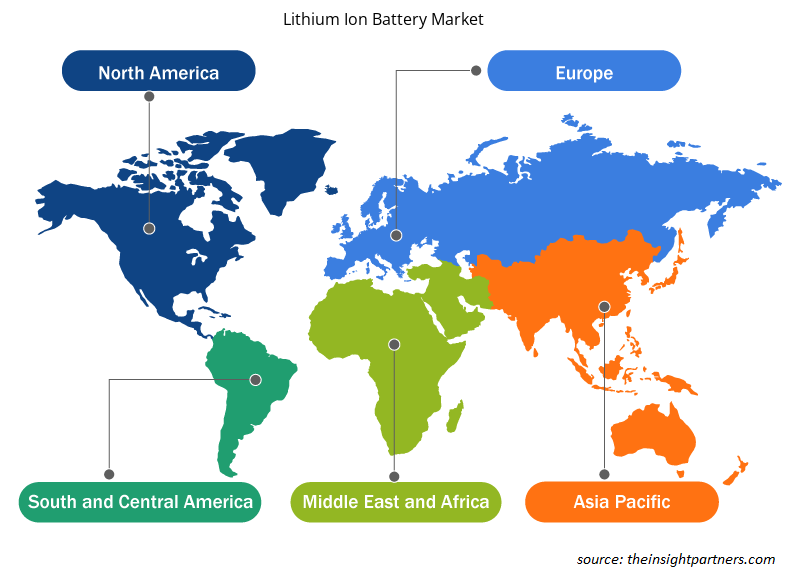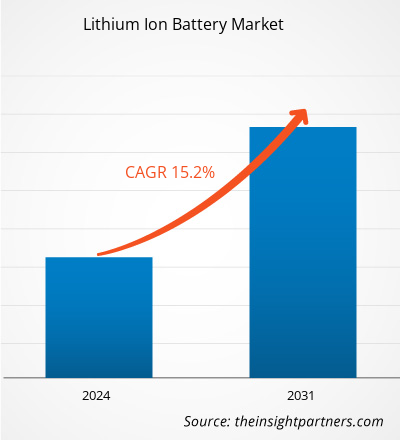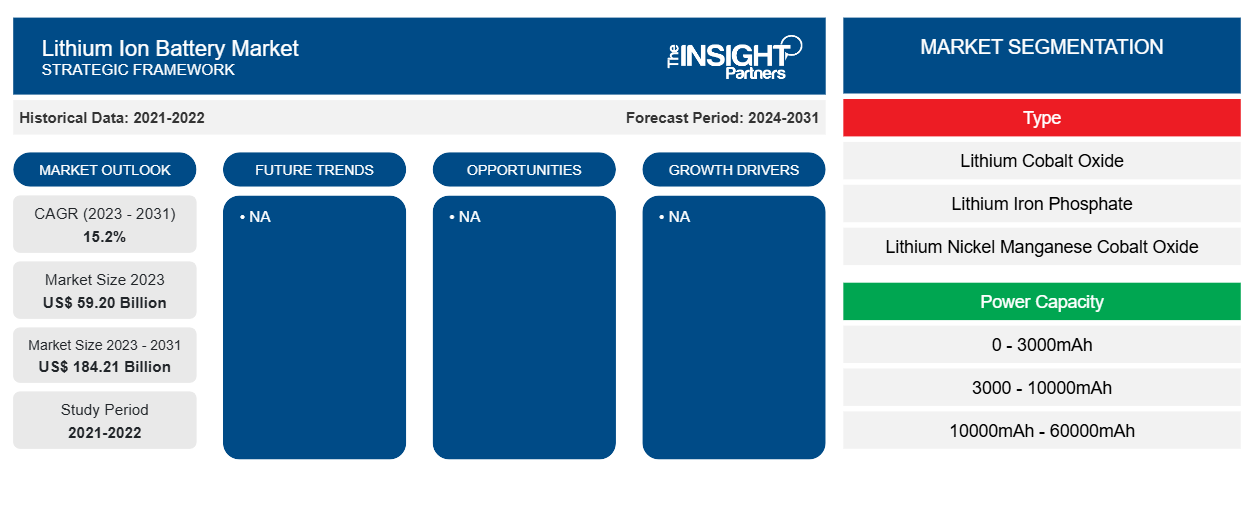Der Markt für Lithium-Ionen-Batterien soll von 59,20 Milliarden US-Dollar im Jahr 2023 auf 184,21 Milliarden US-Dollar im Jahr 2031 anwachsen. Der Markt soll zwischen 2023 und 2031 eine durchschnittliche jährliche Wachstumsrate (CAGR) von 15,2 % verzeichnen. Aufgrund der niedrigen Kosten für Lithium-Ionen-Batterien wird für den Automobilsektor ein deutliches Wachstum prognostiziert.CAGR of 15.2% in 2023–2031. The automotive sector is predicted to increase significantly because of the low cost of lithium-ion batteries.
Lithium-Ionen-Batterie-Marktanalyse
Lithium-Ionen-Batterien werden häufig als Notstromquellen für Gewerbegebäude, Rechenzentren und Organisationen verwendet. Darüber hinaus werden Lithium-Ionen-Batterien zur Energiespeicherung in privaten Photovoltaik-Systemen eingesetzt. Diese Gründe werden im Prognosezeitraum den Ausbau von Energiespeicheranwendungen vorantreiben. Lithium-Ionen-Batterien werden in einer Vielzahl von Industrieanwendungen eingesetzt, darunter Elektrowerkzeuge, Akkuwerkzeuge, maritime Ausrüstung und Maschinen, landwirtschaftliche Maschinen, industrielle Automatisierungssysteme, Luftfahrt, Militär und Verteidigung, Elektronik, zivile Infrastruktur sowie Öl und Gas.
Lithium
Marktübersicht für Ionenbatterien
Der Lithium-Ionen-Batteriemarkt bezieht sich auf die globale Industrie, die Lithium-Ionen-Batterien produziert, vertreibt und verkauft. Eine Lithium-Ionen-Batterie ist eine wiederaufladbare Batterie, in der Lithium-Ionen als primäre Ladungsträger dienen. Diese Batterien haben ein breites Anwendungsspektrum, darunter tragbare Geräte, Elektrofahrzeuge (EVs), Energiespeichersysteme und die Integration erneuerbarer Energien . Der Markt umfasst alle Aktivitäten im Zusammenhang mit der Herstellung, Forschung und Entwicklung, Rohstoffbeschaffung, Komponentenproduktion, Montage, Vertrieb und Verkauf von Lithium-Ionen-Batterien. Er besteht aus einer vielfältigen Gruppe von Interessenvertretern, darunter Batteriehersteller, Rohstoff- und Komponentenlieferanten, Batteriepack-Monteure, Anbieter von Batteriemanagementsystemen und Endverbraucher.
Passen Sie diesen Bericht Ihren Anforderungen an
Sie erhalten kostenlos individuelle Anpassungen an jedem Bericht, einschließlich Teilen dieses Berichts oder einer Analyse auf Länderebene, eines Excel-Datenpakets sowie tolle Angebote und Rabatte für Start-ups und Universitäten.
- Holen Sie sich die wichtigsten Markttrends aus diesem Bericht.Dieses KOSTENLOSE Beispiel umfasst eine Datenanalyse von Markttrends bis hin zu Schätzungen und Prognosen.
Treiber und Chancen auf dem Lithium-Ionen-Batteriemarkt
Inkl.Steigende Nachfrage nach batteriebetriebenen Materialtransportgeräten in allen Branchen begünstigt den Markt
Die Materialtransportausrüstung hat sich weiterentwickelt, um den sich ändernden Anforderungen der Industrie gerecht zu werden. Im Laufe der Zeit hat die Branche der Materialtransportausrüstung viele technologische Verbesserungen erfahren. Batteriebetriebene automatisierte Materialtransport- und Hebeausrüstung wie z. B. geführte Fahrzeuge, Hebevorrichtungen, Flurförderzeuge und Intralogistiksysteme haben sich technologisch weiterentwickelt. Lithium-Ionen-Batterien werden häufig in Materialtransportausrüstung verwendet, darunter Gabelstapler, Roboter und Bodenunterstützung.intralogistics systems, has advanced technologically. Lithium-ion batteries are widely used in material-handling equipment, including forklifts, robots, and ground support.
Richtlinien und Vorschriften der Regierung
Regierungen auf der ganzen Welt erlassen Regeln und Vorschriften, um die Nutzung von Elektrofahrzeugen, erneuerbaren Energien und Energiespeichertechnologien zu fördern. Diese Bemühungen bieten Anreize, Subventionen und Steuererleichterungen, die die Nachfrage nach Lithium-Ionen-Batterien steigern. Laufende Forschungs- und Entwicklungsbemühungen im Bereich Batterien führen zu kontinuierlichen Fortschritten bei Lithium-Ionen-Batterien. Höhere Energiedichte, längere Lebensdauer, schnelleres Laden und verbesserte Sicherheitsfunktionen sind alles Beispiele für Fortschritte. Diese Entwicklungen treiben das Marktwachstum voran, indem sie das Anwendungsspektrum für Lithium-Ionen-Batterien erweitern.
Segmentierungsanalyse des Marktberichts für Lithium-Ionen-Batterien
Wichtige Segmente, die zur Ableitung der Marktanalyse für Lithium-Ionen-Batterien beigetragen haben, sind Typ, Leistungskapazität und Anwendung.
- Nach Typ ist der Markt für Lithium-Ionen-Batterien in Lithium-Kobaltoxid, Lithium-Eisenphosphat, Lithium-Nickel-Mangan-Kobaltoxid, Lithium-Manganoxid und Lithium-Titanatoxid unterteilt. Das Segment Lithium-Kobaltoxid hatte im Jahr 2023 einen größeren Marktanteil.
- Nach Leistungskapazität ist der Markt in 0 – 3000 mAh, 3000 – 10000 mAh, 10000 mAh – 60000 mAh und >60000 mAh segmentiert. Das Segment 0 – 3000 mAh hatte im Jahr 2023 den größten Marktanteil.
- BezüglichAnwendung ist der Markt in Unterhaltungselektronik, Automobil, Industrie, Energiespeichersysteme, Luft- und Raumfahrt & Verteidigung, medizinische Geräte und andere unterteilt. Das Automobilsegment dominierte den Markt im Jahr 2023.
Marktanteilsanalyse für Lithium-Ionen-Batterien nach geografischer Lage
Der geografische Umfang des Berichts zum Markt für Lithium-Ionen-Batterien ist hauptsächlich in fünf Regionen unterteilt: Nordamerika, Asien-Pazifik, Europa, Naher Osten und Afrika sowie Südamerika/Süd- und Mittelamerika. Der asiatisch-pazifische Markt dominiert den Markt für Lithium-Ionen-Batterien. Der asiatisch-pazifische Markt ist in China, Japan, Indien, Australien, Südkorea und den Rest des asiatisch-pazifischen Raums unterteilt. Die Region ist ein führender Hersteller und Verbraucher von Lithium-Ionen-Batterien. Der asiatisch-pazifische Raum verzeichnet eine hohe Nachfrage nach Lithium-Ionen-Batterien von führenden Herstellern von Unterhaltungselektronik. Technologische Fortschritte in der Unterhaltungselektronik im asiatisch-pazifischen Raum treiben das Wachstum des Marktes für Lithium-Ionen -Batterien voran . China ist ein bedeutender Produzent von Lithium-Ionen-Batterien und macht den größten Teil des Marktes im asiatisch-pazifischen Raum aus. Die Länder im asiatisch-pazifischen Raum investieren mehr in Forschung und Entwicklung, um neue Batterietechnologien zu entwickeln, was das Wachstum des Marktes vorantreibt.
Regionale Einblicke in den Lithium-Ionen-Batteriemarkt
Die regionalen Trends und Faktoren, die den Markt für Lithium-Ionen-Batterien im Prognosezeitraum beeinflussen, wurden von den Analysten von Insight Partners ausführlich erläutert. In diesem Abschnitt werden auch die Marktsegmente und die Geografie von Lithium-Ionen-Batterien in Nordamerika, Europa, im asiatisch-pazifischen Raum, im Nahen Osten und Afrika sowie in Süd- und Mittelamerika erörtert.

- Holen Sie sich die regionalspezifischen Daten für den Lithium-Ionen-Batteriemarkt
Umfang des Marktberichts zu Lithium-Ionen-Batterien
| Berichtsattribut | Details |
|---|---|
| Marktgröße im Jahr 2023 | 59,20 Milliarden US-Dollar |
| Marktgröße bis 2031 | 184,21 Milliarden US-Dollar |
| Globale CAGR (2023 - 2031) | 15,2 % |
| Historische Daten | 2021-2022 |
| Prognosezeitraum | 2024–2031 |
| Abgedeckte Segmente | Nach Typ
|
| Abgedeckte Regionen und Länder | Nordamerika
|
| Marktführer und wichtige Unternehmensprofile |
|
Marktdichte der Lithium-Ionen-Batterien: Auswirkungen auf die Geschäftsdynamik verstehen
Der Markt für Lithium-Ionen-Batterien wächst rasant, angetrieben durch die steigende Nachfrage der Endnutzer aufgrund von Faktoren wie sich entwickelnden Verbraucherpräferenzen, technologischen Fortschritten und einem größeren Bewusstsein für die Vorteile des Produkts. Mit steigender Nachfrage erweitern Unternehmen ihr Angebot, entwickeln Innovationen, um die Bedürfnisse der Verbraucher zu erfüllen, und nutzen neue Trends, was das Marktwachstum weiter ankurbelt.
Die Marktteilnehmerdichte bezieht sich auf die Verteilung der Firmen oder Unternehmen, die in einem bestimmten Markt oder einer bestimmten Branche tätig sind. Sie gibt an, wie viele Wettbewerber (Marktteilnehmer) in einem bestimmten Marktraum im Verhältnis zu seiner Größe oder seinem gesamten Marktwert präsent sind.
Die wichtigsten auf dem Markt für Lithium-Ionen-Batterien tätigen Unternehmen sind:
- Automotive Energieversorgungsunternehmen
- Samsung SDI Co. Ltd.
- Tesla-Tochter
- Toshiba Corporation
- A123 Systems LLC
- GS Yuasa International Ltd.
Haftungsausschluss : Die oben aufgeführten Unternehmen sind nicht in einer bestimmten Reihenfolge aufgeführt.

- Überblick über die wichtigsten Akteure auf dem Lithium-Ionen-Batteriemarkt
Neuigkeiten und aktuelle Entwicklungen zum Lithium-Ionen-Batteriemarkt
Der Markt für Lithium-Ionen-Batterien wird durch die Erhebung qualitativer und quantitativer Daten nach Primär- und Sekundärforschung bewertet, die wichtige Unternehmensveröffentlichungen, Verbandsdaten und Datenbanken umfasst. Im Folgenden finden Sie eine Liste der Entwicklungen auf dem Markt:
- Im Januar 2023 erweiterte die Toshiba Corporation (TOKIO: 6502), ein Unternehmen, das sich mit seinen Technologien, Produkten und Dienstleistungen der Förderung der CO2-Neutralität verschrieben hat, heute sein SCiB-Produktangebot mit der Einführung einer innovativen wiederaufladbaren 20Ah-HP-Lithium-Ionen-Batteriezelle, die gleichzeitig viel Energie und hohe Leistung liefert.
(Quelle: Toshiba Corporation, Unternehmenswebsite, 2023)
- Im Juni 2023 erweiterte EnerSys(R) (NYSE: ENS) seine Lithium-basierten Kapazitäten mit der Eröffnung einer EnerSys Advanced Systems (EAS)-Einheit in Budapest, Ungarn, zusätzlich zu einer bestehenden EAS-Einheit in Horsham, Pennsylvania, in der Nähe von Philadelphia. Diese Erweiterungen sind eine Reaktion auf die wachsende Nachfrage nach Lithium-Ionen-Batterien. Die neue EAS-Einheit in Budapest unter der Leitung von Dr. Laszlo Nagy bietet Kunden zusätzliche Ressourcen für die Entwicklung und Montage fortschrittlicher Lithium-Ionen-Batterien. Sie beschäftigt außerdem ein Team von Ingenieuren für die Kundenbetreuung bei Lithium-basierten Anwendungen.
(Quelle: EnerSys(R), Unternehmenswebsite, 2023)
Marktbericht zu Lithium-Ionen-Batterien – Umfang und Ergebnisse
Der Bericht „Marktgröße und Prognose für Lithium-Ionen-Batterien (2021–2031)“ bietet eine detaillierte Analyse des Marktes, die die folgenden Bereiche abdeckt:
- Marktgröße und Prognose auf globaler, regionaler und Länderebene für alle wichtigen Marktsegmente, die im Rahmen des Projekts abgedeckt sind
- Marktdynamik wie Treiber, Beschränkungen und wichtige Chancen
- Wichtige Zukunftstrends
- Detaillierte PEST/Porters Five Forces- und SWOT-Analyse
- Globale und regionale Marktanalyse mit wichtigen Markttrends, wichtigen Akteuren, Vorschriften und aktuellen Marktentwicklungen
- Branchenlandschaft und Wettbewerbsanalyse, einschließlich Marktkonzentration, Heatmap-Analyse, prominenten Akteuren und aktuellen Entwicklungen
- Detaillierte Firmenprofile
- Historische Analyse (2 Jahre), Basisjahr, Prognose (7 Jahre) mit CAGR
- PEST- und SWOT-Analyse
- Marktgröße Wert/Volumen – Global, Regional, Land
- Branchen- und Wettbewerbslandschaft
- Excel-Datensatz
Aktuelle Berichte
Verwandte Berichte
Erfahrungsberichte
Grund zum Kauf
- Fundierte Entscheidungsfindung
- Marktdynamik verstehen
- Wettbewerbsanalyse
- Kundeneinblicke
- Marktprognosen
- Risikominimierung
- Strategische Planung
- Investitionsbegründung
- Identifizierung neuer Märkte
- Verbesserung von Marketingstrategien
- Steigerung der Betriebseffizienz
- Anpassung an regulatorische Trends





















 Kostenlose Probe anfordern für - Markt für Lithium-Ionen-Batterien
Kostenlose Probe anfordern für - Markt für Lithium-Ionen-Batterien